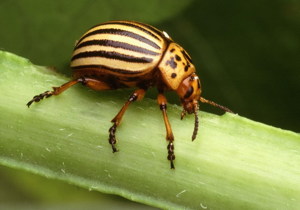Potato Pests

Like most crops, potatoes are affected by various insects and diseases. The Colorado potato beetle and the potato leafhopper are the most damaging insects. Some diseases such as late blight can also be harmful; others are mostly cosmetic, like common scab. Leafhopper damage, or hopperburn, can be mistaken for late blight. Consult your local Cooperative Extension office for help with spud problems.
Colorado Potato Beetle Control
Here are several steps
that help in the battle against CPB.
Soil health – Healthy soil produces healthy plants, and healthy plants experience less insect and disease pressure.
Crop rotation – Rotating plant families in 3–5 year rotations really helps to control insect and disease problems.
Field scouting – In home gardens, as plants emerge, handpick beetles and larvae; drop them into a container of soapy water. Look under the leaves for orange egg masses and squish them.
Planting later than normal – Takes plant emergence out of sync with beetles’ cycle and helps reduce CPB’s early egg laying.
Spraying – If your area is too large for handpicking, you could consider:
- Surround, a kaolin clay formulation, forms a white barrier on leaves.
Grandevo a preparation of Chromobacterium subtsugae that is effective on larvae.
Monterey Garden Spray, a spinosad for home gardens.
Pyganic or Bug Buster-O, broad-spectrum pyrethrum insecticides.
Walking the field – Several days after spraying, handpick larvae that the spray missed.
We list several products for certified-organic growers but be aware that no pest- or disease-control product is allowable without filing a plan for its use under the NOP.

As always, vigilance is the watchword. Please send us your feedback: what worked or didn’t work for you?
If you are trying to identify a pest or need to send an insect or plant sample to a lab for diagnosis, go to UMaine Cooperative Extension: Insect Pests, Ticks and Plant Diseases, a useful website of the insect and plant disease diagnostic laboratory, or contact your local Cooperative Extension Service.
